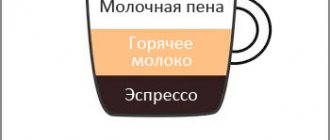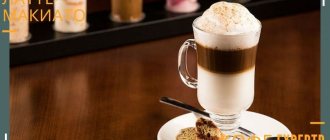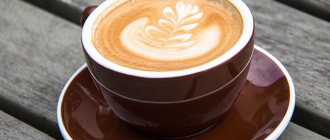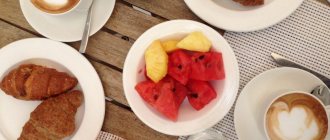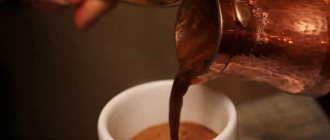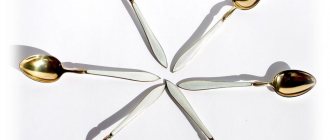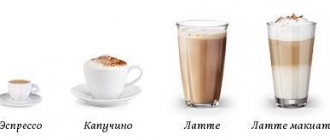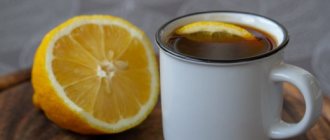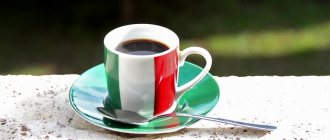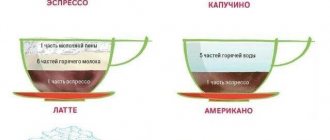There are several theories about the origin of coffee culture. One of them says that coffee originated in Ethiopia in the 5th-10th centuries AD. The now famous shepherd Kaldi noticed how his goats behaved energetically while eating the berries of the coffee tree. The joyful shepherd took them to the monks, to which they said that the berries were the devil and threw them into the fire. As a result of certain events, the monks created a prototype of coffee, which they began to use.
Since that time, the cult of coffee began to spread worldwide, constantly changing and acquiring new forms. Nowadays, every coffee lover knows what a latte and cappuccino are, although he knows about their features only in pronunciation and spelling.
Origin of coffee
Both drinks were invented in Italy.
It’s worth starting with the fact that all the similarities of this pair end with their origin and the ingredients from which they are prepared. Both the first and second come from Italy. Latte is a simplified version of coffee latte, which translates from Italian as “coffee with milk.”
The word cappuccino comes from the Capuchin order, which had a red-brown emblem. The drink was very similar in color to the banner, which is how the world-famous name Cappuccino was assigned to it.
Classic cappuccino recipe
You can make your own cappuccino at home. To do this you will need:
- coffee beans - 2 tsp;
- water - 50 ml;
- milk - 50 ml.
To get delicious coffee, follow these points:
- Mix coffee with water in a pot and brew espresso. The liquid in the Turk needs to be boiled 3 times. This will make the drink stronger.
- Heat the milk to 70 degrees and make foam out of it.
- Pour the frothed milk into the espresso in a thin stream.
- Carefully place foam on top of the drink you have now received. Foam volume is approximately 50 mm.
Difference in Ingredients
The drinks are made from the same ingredients: milk and espresso. It’s just that the proportions of these products are different. Milk in cappuccino is mixed with espresso in a one-to-one ratio. And in Latte - two to one, plus a little foam. Therefore, cappuccino is considered a full-fledged coffee, and latte is considered a delicious coffee drink. But this does not mean that you should write it off, because many visitors to coffee shops and restaurants fell in love with it precisely for its softness and fluffiness of the foam.
Video: How to make espresso correctly
To prepare 1 cup of strong aromatic espresso you need 7 g of coffee and 30 ml of water. To prepare espresso doppio, the amount of coffee is doubled, but the amount of water remains the same. Esperso lungo has a mild taste and weak aroma, since only 4 g of coffee per 30 ml of water is used to prepare it.
Espresso
The hallmark of good coffee is the foam on the surface. If there are holes in the foam, it means that the cooking technology has been violated.
Americano is essentially espresso diluted 1:1 with water. The taste of Americano is not as bright and pronounced as espresso, but its lack of bitterness and minimum caffeine have made this drink popular among adherents of a healthy lifestyle.
There are two ways to prepare Americano:
- In Italian. Coffee is brewed in a coffee maker for no more than 25 seconds. After this, add hot, but not boiling water (1:1) to the drink. If you brew coffee longer, the Americano will become overly bitter and strong. The foam is not preserved.
- In Swedish. Bring water to a boil and remove from heat. In 20-25 seconds, brew the espresso and add it to a cup of pre-prepared water. Americano prepared this way has a milder taste. The coffee foam on the finished drink is preserved.
Americano
Differences in the preparation of drinks
Cappuccino is distinguished by a more densely whipped foam.
If we take the classic method of preparing cappuccino, it is prepared as follows: espresso, usually made on a coffee machine, is poured into a cup. After this, the milk is frothed using steam. If this is not possible, you can shake it in a bottle or shaker.
Then the resulting foam is poured into a cup of espresso in a one-to-one ratio. The foam should be dense. If a handful of sugar is quietly held on the resulting foam, then the cappuccino is prepared perfectly.
The proportion of milk - espresso is increased towards milk
The difference between latte is that it is prepared by mixing the main product with milk in a two to one ratio. The foam in a latte is less thick than in a cappuccino. There is also a latte macchiato. The preparation differs from the first one only in that coffee is added to the finished milk in a ratio of one to two.
Cappuccino
The most popular coffee drink in Italy. Italians drink it exclusively before the lunch siesta and without adding sugar. Cappuccino consists of espresso with the addition of heated foamed milk.
Milk foam for cappuccino is whipped using steam from coffee machines with a cappuccino maker. The name of the drink is associated with the Capuchin monastic order. It resembles the robes of monks - a dark brown robe with a white hood.
The cappuccino is prepared correctly if, when adding sugar, the foam does not settle or spread. It also preserves the temperature and aroma of the drink. Often a serving of cappuccino contains a volume of 150 ml. and served in special glasses.
Gourmets will appreciate torre, a drink that resembles cappuccino and latte at the same time. It is prepared on the basis of espresso, which is covered with foam, thicker and denser than cappuccino.
How does the feed differ?
Cappuccino is served in a porcelain cup, and latte in a glass glass.
Cappuccino should be served in a porcelain cup with a volume of no more than 150 - 200 ml. The temperature of the milk should be approximately 60 – 70 degrees. You need to pour the milk clockwise, slowly and carefully along the walls of the vessel in which the drink is being prepared.
Latte is served in an Irish glass - a glass glass with a fireproof handle with a volume of 250 to 350 ml, where the temperature of the milk does not exceed 60 - 70 degrees.
Making Latte yourself
The basis of the drink is espresso. To prepare a high-quality base, use the services of renting coffee machines in Moscow. After the espresso is ready, you need to prepare the milk. For latte you need a selected product with a mass fraction of fat of 4%. High fat content ensures a soft taste of the drink. Some recipes suggest using a mixture of cream and milk (latte ingredients in equal proportions).
The standard portion is 200 ml. To prepare you will need:
- 50 ml espresso;
- 150 ml of milk or a milk-cream mixture of similar volume;
- sugar to taste.
Algorithm:
- Let's prepare a serving of latte.
- We heat the milk to 40°C. The milk is whipped with a mixer in intensive mode until a coarse foam forms.
- The drink glass is moderately heated.
- Frothed milk is poured into a heated glass.
- Espresso is poured into the milk along the blade of the knife.
The drink is ready.
Which drink tastes stronger?
There is less milk in cappuccino, which is considered a stronger drink
. Cappuccino is considered stronger because it contains less milk, while latte is a softer and more delicate drink. It all depends on the preferences of each person: some like it softer, some like it stronger. Everything is learned by comparison and many people do not immediately notice which of these two types is more delicious.
Cappuccino vs. Latte. The choice is yours!
The words “cappuccino” and “latte” sound like music to coffee lovers around the world. Among coffee and milk drinks, they are the most popular: the sweetness of the milk is ideally complemented by the strength of Italian espresso, and the milk foam makes us feel contrast and harmony.
Essentially, the ingredients of both drinks are the same: espresso coffee, milk and milk froth. So what is their difference?
The name “latte” is an abbreviation for “caffe latte” (Italian), which is what is more correct to call this drink, because “latte” translated from Italian is simply milk.
Taste
Despite the similarity of these drinks, properly brewed cappuccino and coffee latte have different tastes. The taste of the latte is more delicate and light, creamy with a coffee aroma; For cappuccino , the pronounced tones of strong espresso, which is softened by milky notes, are very important. All this is achieved by using some tricks while preparing these coffee drinks.
Cooking technology
For both drinks, chilled milk is poured into a pitcher and frothed using a cappuccino maker. At the same time, a portion of aromatic espresso is prepared. But there are some nuances here:
- For cappuccino, it is important that the foam is as pronounced as possible, so when frothing milk, ideally the foaming phase predominates.
- For a latte, the milk must be denser, so the foaming phase is shorter and the steaming phase is longer. The volume of the milk component for a cappuccino is much less than for a latte.
- Espresso for cappuccino is prepared directly into the cup in which it will be served, and foamed milk is poured on top.
- For a caffe latte, first pour the foamy contents of the pitcher into a heat-resistant glass glass, let it sit for about 40 seconds so that the foam rises and forms a layer, and then espresso is poured into it in a thin stream. Three layers quickly form in the glass: milk, coffee, foam.
Be sure to read: Time-tested products for coffee shops from Aliexpress
View
Looking at a cappuccino , we evaluate its “cap”. It should be dense and glossy. If you pour sugar into a cup and it remains on the surface of the foam, that’s a good sign. Quite often, the surface of a cappuccino is decorated with latte art - patterns obtained through skillful manipulations of the barista when pouring milk froth from a pitcher jug into a cup.
coffee latte through the prism of glass glasses. It has good layering. The bottom layer is milk, the middle layer is coffee, the top layer is foam (there is less of it here than in cappuccino). If the picture you get is exactly this, and not just spotty with foam, the barista knows his business!
Having mentioned spotting, we note that this is not always an omission. “Spotted” coffee is a classic macchiato. This is exactly how its name is translated. Milk is also added to this drink, but in much smaller quantities.
Serving
The method of serving these drinks also differs: cappuccino is often served in a heated porcelain or ceramic cup with a volume of 180-200 ml. with a wide top. In order for the person tasting this drink to enjoy the foam, a small spoon is placed on the saucer, and for those with a sweet tooth, a stick of sugar is placed. Although in Italy it is most often not added: many people have enough of the sweetness of the milk, which becomes distinct when heated to 60–70 degrees.
A good way to serve coffee latte is to serve it in a heat-resistant transparent glass with a handle (Irish-style type). The volume can reach 250-300 ml. For those with a sweet tooth, sugar is offered and a cocktail straw is placed on the saucer. The surface of the milk foam on a latte is also often decorated: these can be patterns drawn from the coffee dot remaining in the center of the foam, or maybe cinnamon or grated chocolate.
Calorie content
If we assume that we take absolutely identical products (the same milk, the same amount of sugar), then the latte coffee will undoubtedly have more calories : it contains more dairy components, and it is this that makes the main contribution to the energy value of these coffee drinks.
Be sure to read: How to replace coffee: 9 delicious and healthy drinks
Judge for yourself: the calorie content of a standard serving of espresso is 4 kcal, and 100 ml. milk with 2.5% fat content – 53 kcal.
If the cappuccino is 180 ml, it will contain no more than 100 ml. milk (it increases greatly in volume) and approx. 57 kcal.
In a large portion of coffee latte, the volume of milk can be 200 ml, and then the calorie content will be 109 kcal. And that's not counting sugar. Although, for the first half of the day this is not a sin at all!
Method of use
cappuccino straight from the cup, savoring the harmony of flavors and textures of its components. If you want to taste the tenderness, then a spoon is at your service, feel free to scoop up the milk foam with it!
a coffee latte through a cocktail straw (it’s probably on your saucer).
The rules of Italian coffee etiquette require drinking both latte and cappuccino exclusively in the first half of the day.
But, no matter which of these two drinks you prefer, perhaps the most important thing is to have fun, which is what we wish for you!
Where is the price higher?
The cost of a latte is more expensive than a cappuccino.
Although the ingredients from which the two types of coffee are made are similar, their proportions are different. Therefore, lattes tend to be more expensive than cappuccinos because they require more milk.
Although sometimes in fast food establishments there is similarity in the price of this product. This is due to the fact that the same glass volume is used for latte and cappuccino, for example, 0.3 liters. or 0.5 l. But this approach is not considered correct, since to achieve the ideal taste of coffee, a certain volume is required: latte - 250-350 ml, cappuccino - 150-200 ml.
The nutritional value
Nutritional value refers to the ratio of BJU of the product. For a balanced classic latte it's:
- 25.5% proteins;
- 27.6% fat;
- 46.9% carbohydrates.
Considering that the drink mostly consists of water, the content of nutritional components in it is small - approximately 2.16 g of protein and 1.35 g of fat, and the mass of carbohydrates is variable - in terms of sweetness.
The calorie content of coffee latte per 100 grams depends on its type, additives and milk fat content. Sugary and decorated coffee, be it cappuccino, macchiato or latte, is significantly higher in calories. To keep your figure and your glucose levels normal, give up sweet recipes and drink your favorite drink almost without restrictions.
How not to confuse latte and cappuccino
Lattes are made in beautiful layers that can be seen through the glass.
Unfortunately, in some establishments lattes and cappuccinos are made incorrectly. This can be easily noticed. If the buyer knows how these two types of coffee are prepared, then he can easily determine whether they are prepared correctly.
A latte macchiato should consist of clearly visible layers: milk, espresso and foam. This will be clearly visible through the glass beaker. A cappuccino consists of darker espresso and crema. Latte consists of light espresso and foam. The foam should be light and thin: even a handful of sugar should sink in it.
It is better not to use sugar so as not to clog the taste of the drink.
If the serving size is smaller or larger than the norm, then the ideal classic taste is unlikely to be achieved. Cafes usually offer standard, medium and large drinks. It is best to buy the standard one, as it is basically equal to the classic volume.
It’s better not to rush to add sugar to your coffee; it can overpower the taste of real coffee prepared using the original technique. It would be much more correct to buy something sweet to go with your drink. It could be a chocolate croissant or a small cheesecake.
The main thing is to drink coffee slowly, enjoying its taste gradually, and this coffee can be either a latte or a cappuccino.
Calorie content of lattes from McDonald's and Starbucks
There is an opinion that coffee from McDonald's and similar fast foods has more calories than homemade coffee. This is only half true. Simple servings contain only ground coffee, water, milk and optional sugar or syrup. Refined sugar or sweet sticks in such places are usually given with you, it is included in the price, but whether to use a sweetener or not is everyone’s personal choice.
Coffee becomes richer in calories when it is additionally decorated with whipped cream, toppings, and crushed nuts. The creamy dome contains approximately 25-80 kcal, and the nuts contain another 60-80 kcal. To reduce calories and make coffee healthier, it is advisable to give up excess carbohydrates, that is, syrups and sugar.
McDonald's and branded coffee shops indicate the composition, BJU and final calorie content of the latte coffee so that customers do not have to calculate it themselves:
- in Mak it is 140 kcal/360 ml, 210 kcal/480 ml;
- at Starbucks – 250 kcal/480 ml in the caramel version;
- at CoffeeHouse – 111 kcal/250 ml in a classic latte and 73 kcal in a low-fat one.
Instant coffee latte drinks contain a fixed amount of calories regardless of the volume of water. Usually their number is indicated on the package next to the BJU and can be 50-100 kcal.
